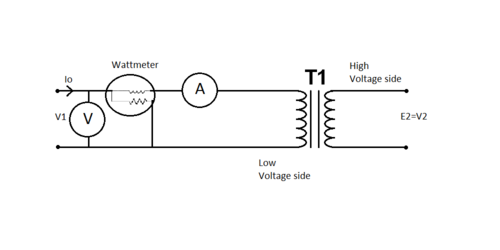Open Circuit Test:-The open-circuit test, or "no-load test", is one of the methods used in electrical engineering to determine the no-load impedance in the excitation branch of a transformer.

Here,
 is the wattmeter reading
is the wattmeter reading
 is the applied rated voltage
is the applied rated voltage
 is the no-load current
is the no-load current
 is the magnetizing component of no-load current
is the magnetizing component of no-load current
 is the core loss component of no-load current
is the core loss component of no-load current
 is the exciting impedance
is the exciting impedance
 is the exciting admittance
is the exciting admittance


Where Re is equivalent resistance of transformer.
If, Ze is equivalent impedance of transformer.

Therefore, if equivalent reactance of transformer is Xe


The secondary of the transformer is left open-circuited. A wattmeter is connected to the primary. An ammeter is connected in series with the primary winding. A voltmeter is optional since the applied voltage is the same as the voltmeter reading. Rated voltage is applied at primary.
If the applied voltage is normal voltage then normal flux will be set up. Since iron loss is a function of applied voltage, normal iron loss will occur. Hence the iron loss is maximum at rated voltage. This maximum iron loss is measured using the wattmeter. Since the impedance of the series winding of the transformer is very small compared to that of the excitation branch, all of the input voltage is dropped across the excitation branch. Thus the wattmeter measures only the iron loss. This test only measures the combined iron losses consisting of the hysteresis loss and the eddy current loss. Although the hysteresis loss is less than the eddy current loss, it is not negligible. The two losses can be separated by driving the transformer from a variable frequency source since the hysteresis loss varies linearly with supply frequency and the eddy current loss varies with the square.
Since the secondary of the transformer is open, the primary draws only no-load current, which will have some copper loss. This no-load current is very small and because the copper loss in the primary is proportional to the square of this current, it is negligible. There is no copper loss in the secondary because there is no secondary current.
The current  is very small.
is very small.
 is very small.
is very small.
If  is the wattmeter reading then,
is the wattmeter reading then,
 is the wattmeter reading then,
is the wattmeter reading then,
That equation can be rewritten as,
Thus,
Impedance[edit]
By using the above equations,  and
and  can be calculated as,
can be calculated as,
 and
and  can be calculated as,
can be calculated as,
Thus,
or
Admittance[edit]
The admittance is the inverse of impedance. Therefore,
The conductance  can be calculated as,
can be calculated as,
 can be calculated as,
can be calculated as,
Hence the susceptance,
or
Here,
 is the wattmeter reading
is the wattmeter reading is the applied rated voltage
is the applied rated voltage is the no-load current
is the no-load current is the magnetizing component of no-load current
is the magnetizing component of no-load current is the core loss component of no-load current
is the core loss component of no-load current is the exciting impedance
is the exciting impedance is the exciting admittance
is the exciting admittanceShort Circuit Test on Transformer
The connection diagram for short circuit test on transformer is shown in the figure. A voltmeter, wattmeter, and an ammeter are connected in HV side of the transformer as shown. The voltage at rated frequency is applied to that HV side with the help of a variac of variable ratio auto transformer.
The LV side of the transformer is short circuited . Now with help of variac applied voltage is slowly increase until the ammeter gives reading equal to the rated current of the HV side. After reaching at rated current of HV side, all three instruments reading (Voltmeter, Ammeter and Watt-meter readings) are recorded. The ammeter reading gives the primary equivalent of full load current IL. As the voltage, applied for full load current in short circuit test on transformer, is quite small compared to rated primary voltage of the transformer, the core losses in transformer can be taken as negligible here.

Let’s, voltmeter reading is Vsc. The input power during test is indicated by watt-meter reading. As the transformer is short circuited, there is no output hence the input power here consists of copper losses in transformer. Since, the applied voltage Vsc is short circuit voltage in the transformer and hence it is quite small compared to rated voltage so core loss due to the small applied voltage can be neglected. Hence the wattmeter reading can be taken as equal to copper losses in transformer. Let us consider wattmeter reading is Psc.
Where Re is equivalent resistance of transformer.
If, Ze is equivalent impedance of transformer.
Therefore, if equivalent reactance of transformer is Xe












No comments:
Post a Comment